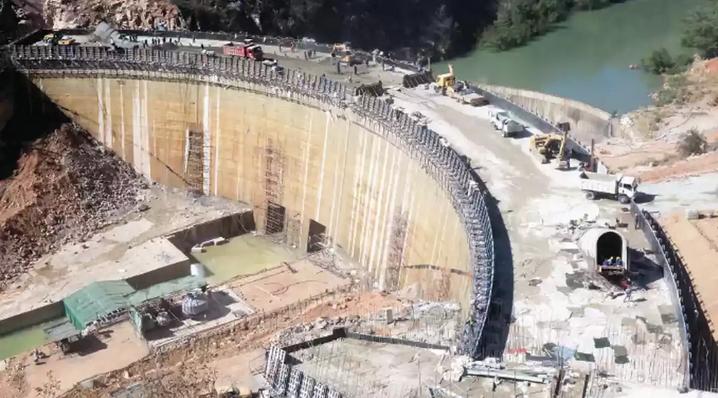News / National
Delay on Lake Gwayi-Tshangani project
17 Oct 2024 at 07:54hrs |
0 Views

The construction of large water booster pump stations at Lake Gwayi-Tshangani in Matabeleland North has revitalized efforts to provide a permanent solution to Bulawayo's long-standing water crisis. This ambitious project, funded by local resources, is part of the Second Republic's multi-faceted approach to addressing water scarcity and overcoming funding challenges during the dam's construction.
China International Water and Electric Corporation (CIWE), the company awarded the tender for the booster stations, has made substantial progress on the project. A total of six booster stations will be constructed along the 245-kilometre pipeline from Lake Gwayi-Tshangani to Bulawayo. During a recent visit, a Chronicle news crew observed active construction at several points along the pipeline, particularly in the border area between Lupane and Tsholotsho Districts.
The Government has engaged 11 companies to carry out the pipeline construction, with local and Chinese teams working under the supervision of the Zimbabwe National Water Authority (ZINWA).
According to ZINWA resident engineer, Elliot Makombe, who is overseeing the Gwayi-Tshangani-Bulawayo pipeline project, the booster pump stations are a key component of the system that will convey water to Bulawayo.
"We are constructing two of the six planned booster pump stations. These stations will help us transport water from Lake Gwayi-Tshangani to Bulawayo," Eng Makombe explained, adding that each tank has a capacity of 6.6 megalitres, designed to ensure steady water flow to the city.
The pump stations are spread across various points, with the water being transferred from station to station, starting from the dam site, through stations in Mabale, Nyamandlovu, and finally to Bulawayo's water treatment facilities in Cowdray Park. From there, water will be distributed to reservoirs at Magwegwe and Criterion.
Once completed, the pipeline is expected to pump 220 megalitres of water daily to Bulawayo, more than enough to meet the city's demand of 160 megalitres per day. Additionally, each booster station will support a 200-hectare irrigation scheme, contributing to the region's agricultural development. Communities along the pipeline, including schools and clinics, will also benefit from access to clean water.
The overall cost of constructing the booster stations is estimated at US$167 million. Under the contract's financing model, contractors must provide 30% of the funding, which has allowed construction to begin before the dam is completed. "The contractor is using 30% of US$167 million to construct pump stations two and three," Eng Makombe noted.
Despite challenges posed by the sandy terrain in the Kalahari region, construction has progressed steadily. "We had to stabilise the soil with geomembrane and concrete to ensure the pump station remains structurally sound," he explained, highlighting the complex engineering involved.
Although the booster stations will only be fully operational once the dam is complete, the construction has already provided employment for local residents, contributing to the area's economic development. The Gwayi-Tshangani project represents a crucial step towards resolving Bulawayo's persistent water challenges and enhancing the region's agricultural potential.
China International Water and Electric Corporation (CIWE), the company awarded the tender for the booster stations, has made substantial progress on the project. A total of six booster stations will be constructed along the 245-kilometre pipeline from Lake Gwayi-Tshangani to Bulawayo. During a recent visit, a Chronicle news crew observed active construction at several points along the pipeline, particularly in the border area between Lupane and Tsholotsho Districts.
The Government has engaged 11 companies to carry out the pipeline construction, with local and Chinese teams working under the supervision of the Zimbabwe National Water Authority (ZINWA).
According to ZINWA resident engineer, Elliot Makombe, who is overseeing the Gwayi-Tshangani-Bulawayo pipeline project, the booster pump stations are a key component of the system that will convey water to Bulawayo.
"We are constructing two of the six planned booster pump stations. These stations will help us transport water from Lake Gwayi-Tshangani to Bulawayo," Eng Makombe explained, adding that each tank has a capacity of 6.6 megalitres, designed to ensure steady water flow to the city.
The pump stations are spread across various points, with the water being transferred from station to station, starting from the dam site, through stations in Mabale, Nyamandlovu, and finally to Bulawayo's water treatment facilities in Cowdray Park. From there, water will be distributed to reservoirs at Magwegwe and Criterion.
Once completed, the pipeline is expected to pump 220 megalitres of water daily to Bulawayo, more than enough to meet the city's demand of 160 megalitres per day. Additionally, each booster station will support a 200-hectare irrigation scheme, contributing to the region's agricultural development. Communities along the pipeline, including schools and clinics, will also benefit from access to clean water.
The overall cost of constructing the booster stations is estimated at US$167 million. Under the contract's financing model, contractors must provide 30% of the funding, which has allowed construction to begin before the dam is completed. "The contractor is using 30% of US$167 million to construct pump stations two and three," Eng Makombe noted.
Despite challenges posed by the sandy terrain in the Kalahari region, construction has progressed steadily. "We had to stabilise the soil with geomembrane and concrete to ensure the pump station remains structurally sound," he explained, highlighting the complex engineering involved.
Although the booster stations will only be fully operational once the dam is complete, the construction has already provided employment for local residents, contributing to the area's economic development. The Gwayi-Tshangani project represents a crucial step towards resolving Bulawayo's persistent water challenges and enhancing the region's agricultural potential.
Source - The Chronicle
Join the discussion
Loading comments…

























